Exploring the Depths of Resin Amber: Nature's Time Capsule
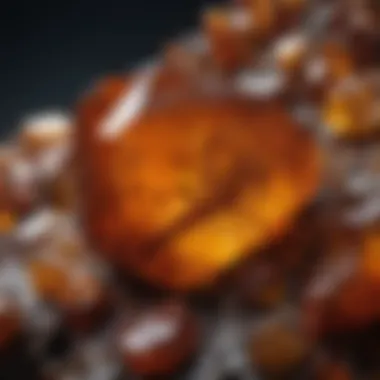
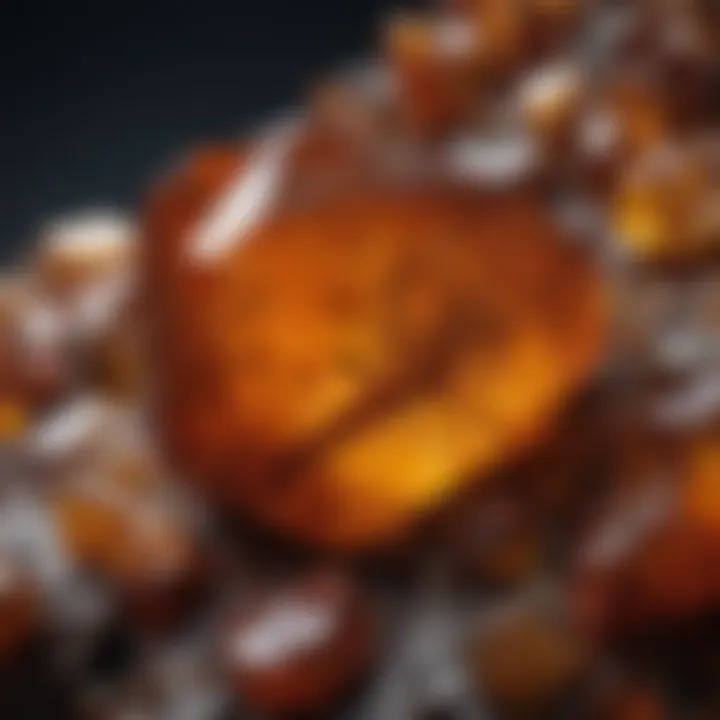
Intro
Resin amber, often referred to as nature’s time capsule, holds within it the stories of eons past. This organic gem provides a bridge connecting the present with the happenings of millions of years ago. As tree sap hardens and transforms over time, it encapsulates not only the environment of its origin but also the innumerable organisms that once thrived alongside those trees. From the glistening surface of a piece of amber, one can peer into a world where ancient insects buzzed around, and lush forests stretched endlessly.
For those who collect, study, or simply admire this captivating substance, understanding its formation and historical significance is crucial. Before diving deeper into the practical aspects of collecting, it’s vital to grasp the historical contexts that shaped the ways civilizations cherished amber.
History and Origins
Overview of Collectibles, Rocks, and Fossils
Collecting amber is more than just a hobby; it’s an entry point to understanding geological and biological processes. Amber is classified under fossilized tree resin, a category that includes other similar substances, yet it stands out due to its beauty and transparency. As a collectible, it embodies both aesthetic and scientific values.
Historically, amber was treasured by ancient societies. It was used not just in jewelry but also in rituals and trade. Some civilizations believed amber possessed magical properties, capable of warding off bad spirits or promoting health.
Historical Significance and Cultural Impact
Amber's significance can be traced back to ancient civilizations. The Romans valued it for its beauty and durability, often crafting intricate jewelry. In Baltic regions, amber was turned into amulets and decorative pieces, reflecting its cultural importance.
"Amber was not just a piece of the tree; it was considered a fragment of the heavens, a piece of starlight introduced into the world of mortals."
These views and beliefs showcase how integral amber was in rituals and societal foundations. The trade routes of the amber road stretched from the shores of the Baltic Sea, winding through Europe and into the heart of ancient Rome. This extended the amber appreciation well beyond limited geographic regions.
As we shift focus on to contemporary society, amber is rediscovered and celebrated for its ability to connect people with the ancient past. From fossil parks to museums displaying amber collections, its allure continues to captivate collectors across generations. Ambers delicate beauty, fossilized within, has fueled countless stories, making it essential for those engaged in rock and fossil collection to comprehend its profound historical narratives and implications.
Identification and Classification
Guide to Identifying Rocks and Fossils
Identifying amber can sometimes feel like finding a needle in a haystack, but a few key characteristics can simplify the process. When examining potential finds, keep an eye out for:
- Color: Natural amber comes in shades of yellow, orange, and even green or blue.
- Inclusions: Look for trapped insects or organic materials; these give amber its charm and often enhance its value.
- Light Test: Amber typically fluoresces under UV light, appearing more vibrant.
- Scratch Test: Authentic amber is slightly softer; a gentle scratch may reveal a distinct dent.
Common Types and Variations
Amber is diverse, showcasing a range of types based on its geographical formations. Some notable types include:
- Baltic Amber: Known for its rich color and inclusions. Widely regarded as the most coveted type.
- Dominican Amber: Often contains well-preserved inclusions, from insects to plants, and is lighter in weight.
- Burmese Amber: It has a deeper hue and is usually older, often associated with ancient species.
Understanding these variations is paramount for collectors wishing to build their knowledge and expertise in amber acquisition. Each type carries its own story, a tale embedded within a solidified drop of time.
Foreword to Resin Amber
Resin amber, often seen as mere decorative stones, holds far more significance within the realms of geology and paleontology than one might first imagine. Its intricate formation process, combined with the organic materials preserved within it, creates a favorable lure for these collectors. Understanding amber is akin to unlocking nature's diary, recounting tales dating back millions of years, and providing a tangible link to ecosystems long vanished. As we delve into the essence of resin amber, it's clear that it serves as both a scientific tool and a cultural artifact, reinforcing its multifaceted importance throughout history.
Definition of Resin Amber
In simple terms, resin amber is fossilized tree sap that has undergone a transformative journey through time. This sticky substance, secreted by coniferous trees, begins as a viscous liquid that hardens over periods—sometimes spanning tens of millions of years. During its journey to fossilization, it can capture small organisms, air bubbles, and plant material within its amberous embrace, creating miniature time capsules from the past. The shades of amber can vary from vibrant yellows to striking blues and even deep browns, often delighting both casual onlookers and serious collectors alike.
Historical Context
The allure of amber is evident through various historical records stretching from ancient civilizations to modern-day collectors. This substance was treasured by ancient cultures who often believed it possessed mystical properties. For example, the Baltic Amber trade flourished over 3,000 years ago, where much of Europe coveted this golden gem both for its beauty and alleged protective qualities. It was a significant trade item in the Amber Road, a network of trade routes connecting the Baltic region with the Mediterranean.
"Amber is a stone that travels across time and space, connecting us to experiences that once were."
Throughout the ages, many civilizations from the Romans to the Native Americans harnessed the power of amber, adorning ceremonial items and crafting jewelry. Its presence in burial sites signifies its role in rituals and beliefs concerning the afterlife. Notably, in the modern era, amber has captured the attention of scientists and enthusiasts alike; its unique capacity to preserve organic material offers insights into prehistoric life forms and environments. Consequently, diving into the historical context of resin amber not only enriches our understanding of its geological roots but also highlights the profound relationship humans have cultivated with this remarkable substance.
Formation and Composition
Understanding the formation and composition of resin amber is key to appreciating its role in the fossil record and its significance in various fields. This section not only delves into how amber is created, but it also examines what amber is made of, shedding light on its physical and chemical properties. For collectors, this knowledge can enhance both appreciation and valuation of their specimens, making it an undeniably valuable topic in the study of this fascinating organic material.
The Process of Fossilization
Fossilization is a slow, intricate dance of nature that takes ages to unfold. When a tree secretes resin—typically as a defense mechanism against injury or disease—it flows down the bark and may eventually harden over time. Picture a pine or an amber tree in a prehistoric forest. The resin oozes out and traps tiny organisms—like insects, plant matter, or even microorganisms—creating a time capsule that preserves them for millennia.
The calamity of nature plays its role too. Natural events such as falling trees or flooding can bury the resin under layers of sediment, shielding it from the atmosphere. As this process continues, heat and pressure from overlying layers contribute to the hardening of the tree sap into amber. A whole ecosystem, captured in what can be a beautifully clear or cloudy golden artifact, emerges after several thousand years—a true snapshot of Earth’s past.
Residents of the ancient forests may find themselves trapped in this golden goo, never again to roam free but instead to offer insights into a party of life long gone.
Chemical Composition of Amber
The chemical makeup of amber is as intriguing as its physical appearance. Primarily composed of organic compounds, amber's principal component is resin acid—the same substance that gives it a distinct smell when polished. Notably, the composition varies widely based on its botanical source, geographical setting, and the time elapsed since the resin was formed.
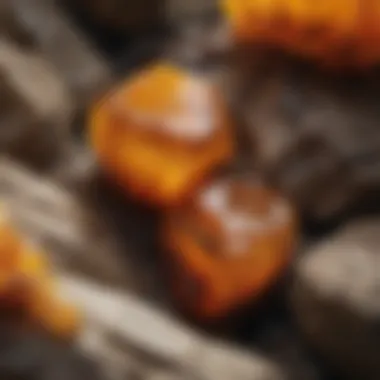
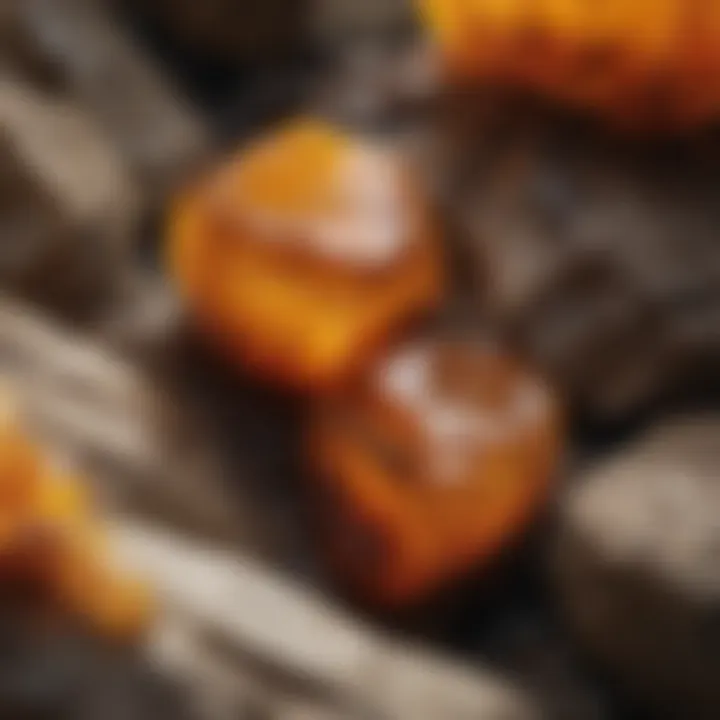
Typically, amber is a polymer called copal, consisting of several main compounds:
- Succinic Acid: Usually the most abundant, it gives amber some of its medicinal properties.
- Terpenes: These organic compounds contribute to the fragrance of the resin and vary based on the plant's origin.
- Phenolic Compounds: They impart color and stability, enhancing the amber's beauty.
- Caryophyllene and Limonene: These compounds are often present in lower quantities, yet they add to the scent profile of the amber.
The intriguing mix of these organic materials contributes not only to amber's mesmerizing visual allure but also to its variances in durability and aesthetic appeal. Collectors often look for unique colors, clarity, and inclusions, all of which stem from this complex chemistry.
Did you know? Different chemical compositions can lead to variations in amber's hardness, clarity, and even color, creating a diverging spectrum that collectors value highly.
In summation, the formation and composition of resin amber stand as a testament to nature’s artistry and diversity. Understanding these elements invites a deeper appreciation for amber, making it more than just a beautiful piece of jewelry or decoration—it is a fragment of history waiting to be explored.
Types of Amber
Understanding the types of amber is fundamental when delving into its significance. Each type not only showcases the diversity of amber but also reflects a unique story of its origin, formation, and usage. Collectors need to appreciate these differences as they play a crucial role in both value assessment and how amber is utilized in various applications. Some types are rarer than others and can fetch higher prices in the market. Hence, knowing what differentiates these types is essential for informed collecting.
Identifying Different Types
Identifying the various types of amber can be a daunting task, especially for newcomers. Here’s a brief run-through of some distinct characteristics:
- Baltic Amber: Usually golden or yellow in color, it is known for having a high concentration of succinic acid, which is often touted for its healing properties. Its age ranges from 35 to 50 million years. This amber is widely collected and often found in Northern European countries.
- Dominican Amber: This type showcases a clear, sometimes jelly-like appearance. Its vibrant hues range from blue to green, adding to its aesthetic appeal. It's seen as a more modern amber, forming approximately 20 to 30 million years ago.
- Burma Amber: Darker in appearance and often inclusive, Burma amber is less commonly found today. It dates back to about 99 million years, which makes it quite fascinating for collectors aiming for ancient specimens.
- Mexican Amber: Known for its rich, warm tones ranging from orange to reddish-yellow, this amber can encase tropical inclusions like insects. Its vivid colors and inclusions often make it a favorite among collectors.
When identifying amber, one must also consider the presence of inclusions. Insects trapped within the amber can often provide hints about the environment during the time of formation. However, be aware, many fakes exist, so always verify authenticity.
Geographical Variations
The geographical origin of amber greatly influences its properties, composition, and value. Each region contributes distinct characteristics:
- Europe: Predominantly Baltic amber, which is recognized worldwide. The cold climate contributes to high-quality amber with a dense makeup.
- Caribbean: The Dominican Republic is a hotspot for Dominican amber, containing significant amounts of inclusions from various species, thus adding to its allure.
- Southeast Asia: Myanmar (Burma) is known for its ancient deposits that often contain prehistoric inclusions. While the amber is dark, the historical significance skyrockets its desirability.
- North America: Amber found in the U.S., particularly in New Jersey and the Pacific Northwest, often differs chemically and visually from its European counterparts.
Understanding these geographical variations enriches the collector's experience. It allows collectors to become more aware of the amber they encounter and the stories behind each piece, making the act of collecting not just a hobby, but a profound journey into history and the natural world.
"Each piece of amber tells a story, capturing not only the organic material but also the environmental context in which it formed."
In summary, digging into the types of amber reveals much about the natural world as well as cultural heritage. Ambitious collectors should take time to understand these variations, as they will significantly enhance their appreciation for this captivating fossil.
Paleontological Significance
The study of paleontology often walks hand-in-hand with the examination of fossilized remains, and that's where resin amber truly shines. This natural material is not simply a beautiful artifact; it holds a treasure trove of information about ancient ecosystems. Understanding its paleontological significance offers insights into the past that are unmatched by other fossil records. With amber’s ability to trap organisms in pristine condition, it serves as a unique time capsule, giving scientists a snapshot of life millions of years ago. This aspect alone elevates amber from mere decoration to a critical component of paleontological research.
Inclusion of Organisms in Amber
One of the most fascinating characteristics of amber is its capacity to enclose living organisms, ranging from insects to small vertebrates, all of which were caught in the sticky resin as it flowed from trees. This entrapment is not random; it often reflects a particular moment in history—a fly buzzing by, or a spider weaving its web in the shade of prehistoric trees.
The discovery of these inclusions has opened pathways to understanding biodiversity in ancient times. Consider the Cretaceous Period, when dinosaurs roamed the earth. Amber from that era has been found to contain ancient mosquitoes, and studies of these inclusions can hint at the types of flora and fauna that constituted the ecosystems of the time. Notably, the study of amber inclusions can also shed light on extinction events, climate change, and how species adapted—or failed to adapt—over epochs.
Moreover,
"Amber proving to be a time capsule of the biological and ecological conditions of the past adds depth to our understanding of evolution and adaptation."
This insight provides a fascinating context for both professional paleontologists and enthusiastic collectors.
Amber as a Window to the Past
The layers of history embedded in amber can be likened to the rings in a tree. When one looks through a piece of amber, they can literally peer back into time, observing landscapes and ecosystems that existed long before humanity. This aspect imbues amber with a narrative quality, as each piece encapsulates a distinct story.
Studies of amber assist in reconstructing ancient climates and environments. For instance, pieces sourced from the Baltic region have yielded significant access to the Eocene epoch, revealing how plant species evolved and morphed during drastic climatic shifts. Additionally, sophisticated methods such as spectroscopic analysis allow scientists to analyze the chemical makeup of the trapped organisms and the resin itself, granting deeper insights into factors like atmospheric conditions during the time of entrapment.
For collectors, having a piece of amber isn’t just about possession; it's about owning a fragment of Earth's history. Each piece tells a tale that intertwines with ours, reminding us of the fragile nature of life and the slow passage of time.
Understanding these aspects encourages respect for our planet's past and appreciation for the delicate balance of ecosystems that have existed long before our own.
Cultural Implications
Understanding the cultural implications of resin amber reveals a fascinating intersection of history, art, and human connection with nature. For centuries, amber has not just been treated as a mere fossilized resin; it has held significant meaning and value across various civilizations. This section explores how diverse cultures perceived and utilized amber, reflecting their beliefs, practices, and even social structures.
Amber in Ancient Civilizations
Amber’s allure dates back to the ancient world, where it was highly regarded for its beauty and supposed properties. From the early Greeks and Romans to the Baltic tribes, amber was a sought-after material.
In ancient Greece, for instance, amber was linked to the sun, believed to be the tears of the sun god Helios. People saw it as a source of warmth and light in their lives. The Greeks would use it in jewelry, reinforcing not just beauty but also implying power and prestige, often wearing it during significant events.
Meanwhile, the Romans valued amber for its ability to conduct static electricity; they noticed that when rubbed, it could attract light objects like feathers. This phenomenon led to a belief in its magical properties. In addition, Roman traders traveled vast distances to access the Amber Road, a crucial trade route that linked the Baltic Sea to the Mediterranean Basin, underscoring the high demand and importance of this precious gem.
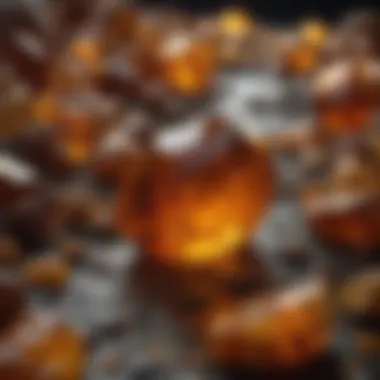

Amber in Folklore and Myths
Amber has also woven itself into the fabric of folklore and mythology worldwide, often symbolizing life, eternity, or protection. For example, in many European cultures, amber was considered a protective talisman. Folk tales state that wearing amber can ward off evil spirits and protect children from harm.
In Slavic mythology, amber was thought to embody the souls of the ancient forest, acting as a bridge between the living and the spirit world. It featured prominently in rituals designed to connect with ancestors, as it was believed to house the wisdom of the past.
Additionally, the legends of the Baltic region are rich with references to amber. One tale suggests that the Amber Room, a stunning chamber in Russia, was crafted by merging the essence of sunlit days and the aeons of history captured in amber, further emphasizing its significance in cultural memory.
"Amber is not just a gemstone; it is a capsule of history, a connection to what has come before us, and a testament to the values we hold dear."
These examples underscore that amber is more than a decorative item. It embodies our collective experiences, beliefs, and the ways we have related to our environment through the ages, establishing it as a multifaceted cultural artifact.
As scholars and collectors delve into the layers of meaning surrounding amber, they uncover the stories that have been passed down through generations, reminding us that even in geological time, humanity's narrative remains intertwined with the natural world.
Modern Applications
The realm of resin amber extends beyond its captivating appearance; it serves various practical and scientific uses that connect the past to the present. Understanding these modern applications elevates the appreciation of amber, providing insight into how this ancient resin continues to impact contemporary society and industry. From craftsmanship to scientific inquiries, the relevance of amber today cannot be overstated. It embodies a fusion of beauty and utility, making it a subject of interest not only for collectors but also for artists and researchers alike.
Art and Jewelry Making
Amber has long held a cherished place in the world of art and jewelry making. Its vivid hues and translucent quality make it a favorite among artisans. The processes of shaping and finishing amber require a fine balance of skill and creativity, producing stunning pieces that capture the imagination. For jewelry makers, the allure of amber lies in its natural beauty; each stone tells its own story, exhibiting varying shades of deep orange to bright yellow with occasional inclusions that add character.
Crafting jewelry from amber also involves intricate techniques:
- Polishing: A smooth finish enhances the natural colors, allowing light to dance across the surface.
- Inlay: Combining amber with materials like silver or gold opens new avenues for artistic expression.
- Sculpting: Some artisans take it further, carving detailed designs that transform amber into exquisite works of art.
Importantly, jewelry made from amber is often marketed as a unique gift, reflecting personal connections and emotions. Wearing a piece of amber jewelry can serve as a statement of individuality and style. Moreover, the use of amber in art forms can echo cultural stories, embedding historical contexts into modern fashion.
Scientific Research
Beyond its aesthetic allure, amber is also a valuable resource for scientific research, particularly in the fields of paleontology and entomology. The inclusion of ancient organisms within amber offers a literal snapshot of life from millions of years ago, unlocking secrets of evolution and biodiversity. Scientists meticulously study these inclusions to better understand environmental conditions of past eras.
Some vital aspects of amber in scientific exploration include:
- Fossil Preservation: The exceptional preservation properties of amber allow for the study of delicate structures, like feathers and insect wings, which might not survive in traditional fossil records.
- DNA Analysis: Recent advancements enable researchers to extract ancient DNA from inclusions, revealing genetic information that fuels questions about species adaptations and extinction.
- Climate Insights: Analysis of amber can provide clues to climate conditions of the past, aiding researchers in projecting future climatic trends.
"Amber is not just a fossil, it's a time machine that offers glimpses into bygone ecosystems."
The significance of amber in modern research highlights its dual role as both a natural marvel and a scientific tool. Consequently, it fosters a bridge between the history encapsulated within and the pressing questions of today's scientific community.
By diving into the applications of amber in art and science, one understands its enduring legacy and potential for future discoveries. From appreciating beautiful jewelry to engaging in scientific inquiry, resin amber serves as a profound reminder of nature's script preserved through time.
Collecting Amber
Collecting amber can be a rewarding venture, appealing to those who have a deep appreciation for nature's art and the secrets it holds. This fossilized tree sap, which has been around for millions of years, not only enchants collectors with its vibrant colors and inclusions but also provides a tangible link to a prehistoric world. Engaging in amber collection brings with it a myriad of benefits, from personal satisfaction to educational opportunities and even financial investment.
When one delves into the world of amber, the initial allure often stems from its unique appearance—ranging from golden hues to deep earthy browns. Each piece can tell a story, offering a glimpse into the lives of organisms that once existed within it. Thus, the importance of collecting amber extends beyond aesthetics; it becomes a means of preserving history.
Initial Steps for New Collectors
For those just starting out, navigating the amber collecting landscape can feel akin to walking through a dense forest without a map. Here are foundational steps to help ease the process:
- Research Before You Buy: Understand what amber is, its types, and where it can be found.
- Join a Community: Engaging with experienced collectors through forums like reddit.com can provide invaluable insights and tips.
- Attend Shows or Fairs: Local gem and mineral shows often feature amber vendors, presenting a hands-on opportunity to see different types and meets fellow enthusiasts.
- Start Small: As a beginner, consider acquiring less expensive pieces. This allows you to learn about quality without breaking the bank.
- Network with Other Collectors: Building relationships with seasoned collectors can open doors to acquiring better pieces and gaining knowledge.
It’s essential, especially in the beginning, to have patience and stay curious. Every collector has their unique journey filled with discoveries, and it’s through careful observation and learning that you begin recognizing the nuances of quality.
Evaluating Quality and Value
Determining the quality and value of amber is pivotal to expanding a collection wisely. Several factors come into play when assessing a piece:
- Transparency and Clarity: High-quality amber tends to be clear or lightly clouded. Pieces with extensive internal imperfections might be less desirable.
- Color: Different colors fetch different values—deep cognac or green pieces can command higher prices than typical yellows.
- Inclusions: Amber is renowned for encapsulating organisms or plant material. Unique or rare inclusions can dramatically increase value, with certain specimens being genuinely priceless.
- Origin: Where the amber is sourced from can affect its value. For instance, Baltic amber is highly sought after due to its historical significance and abundance of inclusions.
"When purchasing amber, a certified appraisal can save heartache down the line."
In summary, collecting amber not only fulfills a personal passion but also connects to natural history and science. With the right approach, new collectors can cultivate a meaningful collection that may even become an invaluable asset over time.
Preservation Techniques
Preserving resin amber is paramount for collectors and enthusiasts alike. Amber, being a delicate material, requires a well-thought-out approach to maintenance and storage. Missteps in keeping this fossil can lead to discoloration, cracking, or even irreversible damage. By understanding the significance of proper preservation methods, collectors can ensure that their amber specimens remain stunning and intact for generations.
Cleaning and Handling Amber


When it comes to cleaning amber, a gentle touch is crucial. Here's how to go about it:
- Optimal Cleanser: Use warm, soapy water mixed with a few drops of mild dish soap. Never use harsh chemicals, as these can ruin the surface.
- Soft Cloth Usage: Employ a microfiber cloth or natural sponges to wipe the surface. Avoid abrasive materials that might scratch the amber.
- Dry Thoroughly: Pat the amber dry with a soft, dry cloth after cleaning to prevent any water spots from forming.
Handling amber carefully is equally important. When you hold a piece, it’s best to avoid using too much pressure and refrain from touching the surface with bare fingers, since oils can leave marks or build up over time. It might seem slight, but small things can feel like big daals when you want your amber to shine like a new penny.
Storage Recommendations
Storing amber properly can safeguard it from environmental factors that lead to degradation. Consider the following:
- Stable Climate: Find a cool, dry place that’s not subject to temperature fluctuations. Humidity can wreak havoc on amber!
- Soft Storage Containers: Wrap each piece in a soft, non-abrasive cloth, ideally a cotton one, or store it in individual cloth pouches. This helps prevent scratches.
- Avoid Direct Sunlight: Exposure to sunlight can cause colors to fade. Keep them in a dark, secure area.
- Display Carefully: If you wish to showcase your collection, consider using UV-filtering glass cases to shield them while allowing view.
"Proper preservation not only enhances the aesthetics of amber but also significantly contributes to its longevity."
By methodically cleaning and storing amber, collectors can safeguard their treasures. Each piece of amber is not merely a beautiful item but a fragment of history, and with the right preservation techniques, they can continue to recount their ancient tales.
Challenges in Amber Collection
Collecting amber can be as delightful as it is daunting. For enthusiasts and collectors alike, the beauty and historical significance of amber make it a coveted prize. However, there are challenges that one must navigate carefully to ensure their collection is both authentic and worthwhile. Understanding these challenges not only enhances the collecting experience but also helps to preserve the integrity of the market and its fascinating history.
Detecting Fake Amber
The counterfeit market for amber has bloomed, much like a weed in a garden. Recognizing genuine amber from imitations is critical for any collector. Here are some strategies:
- The Scratch Test: Real amber has a degree of softness, which means a slight scratch can sometimes reveal its authenticity. If it scratches easily, there’s a chance it might be genuine.
- The Salt Water Test: Dropping the stone into a saline solution can also help. Genuine amber will float, while most fakes sink.
- Ultraviolet Light: When exposed to ultraviolet light, amber often glows in warm yellow or orange hues, a feature that most synthetics lack.
"The charm of amber lies not just in its visual appeal, but in the stories it holds within its depths."
While these methods can be effective, one should also be wary of archaic tricks that may lead to erroneous conclusions. Consulting with experienced collectors or expert dealers can further bolster your confidence in determining authenticity.
Market Trends and Prices
The market for amber is as fluid as honey. Prices fluctuate based on factors like clarity, size, location, and even the presence of inclusions. Prices can range drastically:
- Bulgaria and Baltic Amber: Known for their deep hues and high quality, this region’s amber can cost upwards of hundreds and thousands of dollars per carat.
- Dominican Amber: Often features unique inclusions and garners high market demand; its price reflects this rarity.
- Quality Over Quantity: Collectors are advised to look for pieces with unique characteristics that tell a story, rather than simply accumulating large quantities.
Factors such as current fads, global economic conditions, and even celebrity influences can drive ambient prices. Consequently, keeping abreast of market trends is integral for making savvy purchases. The right pieces acquired at the right price can not only enhance one’s collection but also serve as invaluable investments for the future.
Future Trends in Amber Studies
The study of amber, particularly from the standpoint of fossilized resin, is an ever-evolving field. Understanding the future trends in amber studies holds significant relevance for collectors, researchers, and museums alike. There are certain advancements and changes that can enhance our understanding of this ancient material, as well as the ecosystems from which it originates. This can shed light on not just the past but also inform us about future ecological dynamics.
Advancements in Technology
Technology is rapidly reshaping many scientific fields, and amber studies are no exception. Recent enhancements in imaging techniques are helping scientists to delve deeper into the microcosm of inclusions within amber. With methods like micro-CT scanning and high-resolution microscopy, researchers can analyze physical structures from a perspective that was once unimaginable. This has revealed intricate details of trapped organisms, contributing to our knowledge of prehistoric biodiversity.
Furthermore, advances in spectrometry are crucial for chemical analysis. By employing mass spectrometry and infrared spectroscopy, scientists can better understand the chemical composition of amber. This not only aids in identifying the origin of different amber types but also helps in assessing their age and quality. The technology used to study these samples continues to progress, leading to a future where our understanding may reach new heights. With these advancements, we stand poised to uncover not just scientific insights but potential applications for amber in other fields, such as medicine and materials science.
Impact of Climate Change on Amber Deposits
Climate change is an omnipresent issue that extends even into the study of amber. With shifts in temperature and environmental conditions, the geological activity that produces amber deposits is affected. This could potentially alter where amber can be found and in what quantities. An understanding of these impacts becomes crucial for collectors and researchers alike.
For instance, as warmer climates prevail, the ecosystems supporting the trees from which resin is derived may change. The trees themselves might find new territories or even face extinction in certain areas. This can lead to a decline in amber production in regions that were once prolific.
Additionally, sea levels rising could increase the inundation of existing amber deposits, causing loss of these natural treasures. The accessibility of amber may diminish, leading to a more challenging environment for new collectors entering the field. It's essential for those interested in amber not only to keep an eye on the market trends but also to stay informed about the ecological changes that may impact amber's natural habitat.
"As the climate changes, our connection with nature's past through amber may become more tenuous. Insight into this process is crucial for both preservation and appreciation of this timeless treasure."
In summary, the future of amber studies looks promising, yet it requires us to be vigilant. Embracing technology will enhance our research capabilities, while proactive awareness regarding climate change can ensure that amber remains a source of fascination and knowledge for generations to come.
Epilogue
As we draw the curtain on our exploration of resin amber, it's crucial to reflect on the many layers that this ancient substance encapsulates. The importance of resin amber transcends its surface beauty, revealing a vivid and intricate story of past ecosystems and the evolution of plant life on our planet. One can't overlook how each hardened drop of this fossilized tree sap acts as a unique archival record of the Earth’s history, preserving the narratives of organisms long gone.
Recap of Key Points
Throughout this article, we have tackled several significant aspects of resin amber:
- Formation and Composition: We examined how resin turns into amber over millions of years, detailing its chemical makeup and the fossilization process.
- Types and Variations: Different types of amber, influenced by geographical and geological factors, highlight the diverse shades and qualities collectors may encounter.
- Paleontological and Cultural Significance: Amber not only provides insights into prehistoric life but also weaves through the myths and traditions of ancient civilizations.
- Modern Applications: We looked at how amber is appreciated in art and scientific research, making it a valuable commodity.
- Challenges and Future Trends: The potential repercussions of climate change on amber deposits and the ongoing advancements in analytical technologies suggest that the field is ever-evolving.
Each of these points interconnects to create a broader understanding of amber's lasting impact on both science and society.
Encouragement for Further Exploration
Resin amber captures our imagination and piques our curiosity. I urge readers, especially those who have taken their first steps into the realms of collecting or studying geology, to dig deeper. Visit local museums that showcase amber specimens or join a collector's club to connect with likeminded enthusiasts. There is a wealth of research waiting to be uncovered, and we are only scratching the surface.
As we continue to confront the challenges of preservation in an ever-changing climate, further exploration into amber's properties and its historical contexts will yield insight not only into our planet's past but also into how we might influence its future. In a world where ecological concerns are at the forefront, understanding substances like amber can inspire a greater appreciation for our natural heritage.
"Amber is a window that lets us peer into lives that once thrived. To understand it is to understand a piece of ourselves."
Take a moment to reflect, have conversations, and seek out new knowledge about this captivating gem from nature. Your journey into the depths of resin amber is not merely about collecting; it's about preserving the past and enriching the future.



